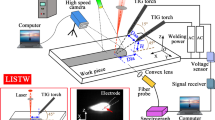Abstract
High-power repetitively-pulsed TEA CO2 lasers are excited by a glow discharge, and it turns out to be the arc discharge under some conditions. The arc-discharge is a disadvantageous condition and must be avoided. According to the Faraday electromagnetism induction principle, the arc-discharge monitoring system with a magnetic-field probe is designed for high-power repetitively-pulsed TEA CO2 lasers. The magnetic-field variation induced by the discharge current can be tested, and the discharge state can be distinguished according to the output induction voltage. Experimental results show that the magnetic-field induction voltages generated by a glow discharge and an arc discharge are very different ones. The maximum induction voltage of the glow discharge is 2.0 V, while the minimum induction voltage of the arc discharge is 2.5–4 V. Three alarm levels are set by measuring the arc-discharge intensities. At the first level, automatic filling–exhausting equipment starts to refresh the gas media, at the second level, the laser repetition rate is reduced, and at the third level the laser operation stops immediately. As a result, the working reliability of a high-power repetitively-pulsed TEA CO2 laser system can be improved significantly by using the arc-discharge monitoring system.
Similar content being viewed by others
References
Randolph L. Carlson, James P. Carpenter, Donald E. Casperson, et al., IEEE J. Quantum Electron., QE-17, 1662 (1981).
Chiyoe Yamanaka, Sadao Nakai, M. Matoba, et al., IEEE J. Quantum Electron., QE-17, 1678 (1981).
Guilong Yang, Dianjun Li, Jijiang Xie, et al., Laser Phys., 22, 1173 (2012).
M. Gautheir, C. G. Cureton, P. A. Hackett, and C. Willis, Appl. Phys. B, 28, 43 (1982).
M. Kumar, V. Gupta, and A. K. Nath, Appl. Phys. B, 80, 757 (2005).
Jean-Francois Coutouly, Pascal Deprez, Florin Breaban, and Jean-Paul Longuemard, J Mater. Process. Technol., 209, 5730 (2009).
Yanchen Qu, Deming Ren, Xiaoyong Hu, et al., Appl. Opt., 41, 5025 (2002).
Neil C. du Preez, Andrew Forbes, and Lourens R. Botha, Proc. SPIE, 7131, 71311E-1 (2009).
Ping Gong, Rongqing Tan, Zhiping Tang, et al., Chin. Opt. Lett., 2, 538 (2004).
Hiroyuki Hagiya, Shigeaki Uchida, and Takashi Yabe, Chin. Opt. Lett., 5, S67 (2007).
Katsumi Midorikawa, Hidekazu Hatanaka, Minoru Obara, and Hideo Tashiro, Meas. Sci. Technol., 4, 388 (1993).
T. Reghu, Manoj Kumar, A. K. Biswas, and L. M. Kukreja, Opt. Laser Technol., 43, 904 (2010).
Shi Lei, Qiu Aici, Wang Yongchang, and Zhou Guozhen, J. Appl. Opt., 20, 7 (2000) [in Chinese].
Liang Kedao, Mi Yan, and Li Chengxiang, High Volt. Eng., 35, 1994 (2009) [in Chinese].
Motohisa Kanda, IEEE T. Antenn. Propag., 41, 1349 (1993).
Author information
Authors and Affiliations
Corresponding author
Rights and permissions
About this article
Cite this article
Meng, F., Li, D., Sun, S. et al. Arc-discharge monitoring system of a high-power repetitively-pulsed TEA CO2 laser. J Russ Laser Res 33, 362–368 (2012). https://doi.org/10.1007/s10946-012-9291-x
Received:
Accepted:
Published:
Issue Date:
DOI: https://doi.org/10.1007/s10946-012-9291-x




